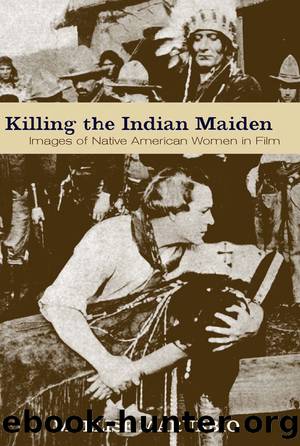Killing the Indian Maiden by M. Elise Marubbio

Author:M. Elise Marubbio
Language: eng
Format: epub
Publisher: The University Press of Kentucky
Published: 2006-08-14T16:00:00+00:00
THE FALLEN PRINCESS AS SEXUALIZED MAIDEN
The image of the fallen Princess has long existed in noncinematic representations of Native American women. Rayna Green’s findings in generations of music and literature reveal that the woman’s “nobility as a Princess and her savagery as a Squaw are defined in terms of her relationship with male figures.” Green argues that the act of sex determines whether a woman is a Princess or a squaw figure—the latter of which is described as unheroic, usually unattractive, and often the butt of jokes.27 Though the film industry challenges this rigid qualification through its multifaceted depictions of the Celluloid Maiden, there are instances in which Green’s findings apply precisely. Two pre-1950s examples, both Cecil B. DeMille characters, stand out as the beginnings of this trend: Naturich (The Squaw Man, 1931) and Hannah (Unconquered, 1947). In both cases, the woman’s birth makes her a Princess character, but particular actions hint at her less savory, darker side. Naturich, as discussed previously, seduces Jim and murders his enemy, and Hannah beats the young white woman, Abby, whom her husband desires. Hannah’s decidedly more aggressive and violent behavior, and DeMille’s depiction of her people as savage reactionaries, ensures her unfavorable image and foreshadows the portrayal of Hesh-ke. But these sliding figures are complex: both women love their white husbands, perform heroic actions, and commit suicide. Although Hannah is more closely linked to the Sexualized Maiden image, she does not exemplify the 1940s type, because of her full-blood Indian heritage and her lack of visible sexuality. Nor does she lean toward later fallen Princess figures, because of her extreme violence. She does, however, signal the shifting hybrid trend of the 1950 and 1960s.
Two representations emerge between 1956 and 1967 that escalate the deconstruction of the symbolic Princess image through the use of Sexualized Maiden characteristics: Look in The Searchers (1956) and Flo in In Cold Blood (1967). Each of the films focuses on a different component of Green’s squaw figure in such a way as to gloss over the woman’s social status and lack of femme fatale qualities. The Searchers frames Look as a plump and comic figure; In Cold Blood depicts Flo as a promiscuous drunk. These two characters reflect the changing depictions of the Sexualized Maiden figure and its eventual hybridization with the Celluloid Princess.
The treatment of Wild Goose Flying in the Night Sky—or Look (Beulah Archuletta)—in John Ford’s The Searchers clues the viewer in to the fact that she is not a Princess figure but, rather, a 1950s Sexualized Maiden. The young Comanche woman’s plump figure and comical representation make her the constant butt of jokes and abuse, which in turn downplays, even negates, her desire to be married and her social status among her people. Look’s position within the narrative structure works on one level as a “vulgar parody of the ‘Indian marriage’ theme that Broken Arrow invests with so much liberal sentiment.”28 On another level, the outright abuse she receives from her husband Martin (Jeffrey Hunter) moves
Download
This site does not store any files on its server. We only index and link to content provided by other sites. Please contact the content providers to delete copyright contents if any and email us, we'll remove relevant links or contents immediately.
The Kite Runner by Khaled Hosseini(4409)
Gerald's Game by Stephen King(3913)
The Perils of Being Moderately Famous by Soha Ali Khan(3781)
Dialogue by Robert McKee(3573)
Story: Substance, Structure, Style and the Principles of Screenwriting by Robert McKee(2981)
The 101 Dalmatians by Dodie Smith(2931)
The Pixar Touch by David A. Price(2735)
Confessions of a Video Vixen by Karrine Steffans(2668)
Fantastic Beasts: The Crimes of Grindelwald by J. K. Rowling(2539)
How Music Works by David Byrne(2519)
Harry Potter 4 - Harry Potter and The Goblet of Fire by J.K.Rowling(2412)
Slugfest by Reed Tucker(2411)
The Mental Game of Writing: How to Overcome Obstacles, Stay Creative and Productive, and Free Your Mind for Success by James Scott Bell(2388)
Wildflower by Drew Barrymore(2114)
Scandals of Classic Hollywood: Sex, Deviance, and Drama from the Golden Age of American Cinema by Anne Helen Petersen(2104)
Casting Might-Have-Beens: A Film by Film Directory of Actors Considered for Roles Given to Others by Mell Eila(2071)
Screenplay: The Foundations of Screenwriting by Syd Field(2051)
Robin by Dave Itzkoff(2002)
The Complete H. P. Lovecraft Reader by H.P. Lovecraft(1970)
